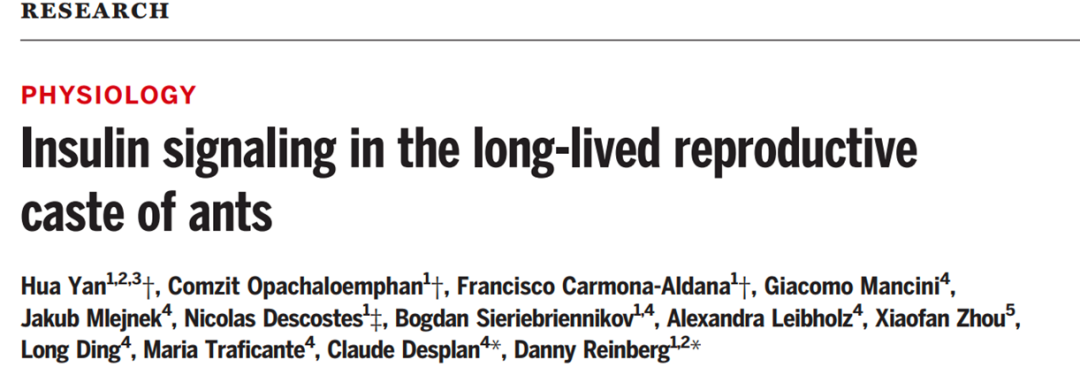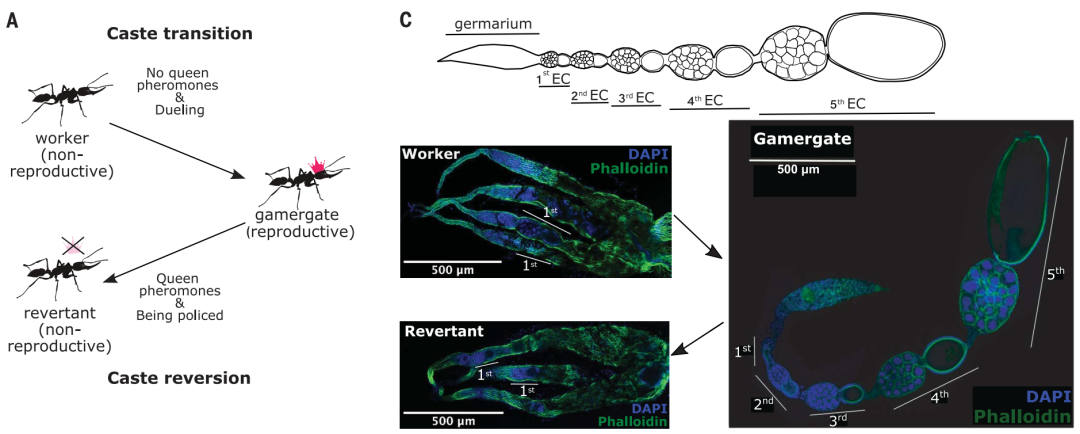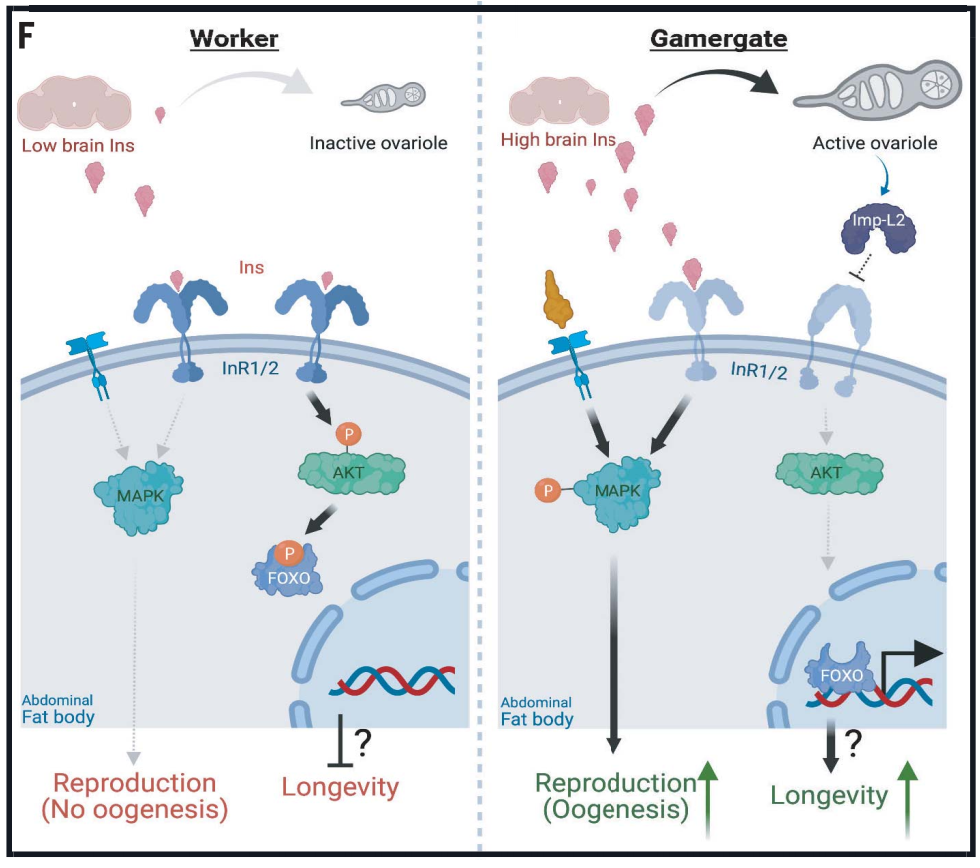Breaking and longevity: two branches of insulin signal pathways in ants
Author:Bioart biological art Time:2022.09.19

Written article 丨 November
#senescence#
In the animal kingdom, breeding offspring and extended life cannot coexist. Genes that are conducive to reproductive health usually shorten life, because animals need to allocate nutrition and metabolic resources in order to reproduce offspring, which is usually at the cost of sacrifice life [1-3]. However, in the whole group of insects, such as ants, bees, horses, and termites, the complete reproductive function of the group depends on one or few female individuals, and the life expectancy of the queen is 30 times compared to non -reproductive female workers. However, it is unknown how to regulate offspring and molecular levels at the same time. To this end, the research group of Danny Reinberg and Claude Desplan of New York University in the United States posted a text in Science entitled INSULIN SIGNALING in the Long-Lived Reproductive Caste of ANTS. Essence

The balance between reproduction and longevity involves insulin and insulin-like growth factor signal pathways (IIS). Studies on the IIS signaling pathway in nematodes, fruit flies, mice, and multi -mode biological biological shows that the IIS signal pathway has an important impact on the regulation of life. Fat Body and ovarian are the main organizations for regulating life and reproductive ability. Fats mainly contain fat cells and fat -fatal cells, similar to the liver and fat tissue of vertebrates, which plays an important role in energy storage and utilization, pheromone synthesis, reproduction and longevity. In fruit flies fat or mouse adipose tissues, the IIS signal channel negative regulatory Foxo transcription factor can be increased to extend life, but it will reduce fertility. In addition, removing the reproductive cells in the ovary can also extend the life of fruit flies and nematode.
The author pays attention to the HarpegnathOS Saltator Ant. When the queen death in the ant colony is died or was removed, the workers began to duel, and the winner gradually transformed into a pseudo -queen. Life is extended to five times the workers' ants (Figure 1). When the ants are placed in a new ant colony, they will also re -become a Revertants, and the life span will become shorter. The average life expectancy of the worker ant is 217 days, the average life expectancy of the pseudo -queen is 1100 days, and the life of the fake ants transferred ants is 188 days. From the perspective of the ovarian, the pseudo -queen has a completely developed ovarian and includes some developed ovarian female cells; in contrast, the ovaries of the workers' ants are very small and do not have a fully developed ovaries (Figure 1).

Figure 1 The conversion between workers ants, queen, pseudo -queen, queen transfer ants, and ovarian development
In order to unveil the specific mechanism of breeding offspring and longevity at the same time, the author conducted a batch RNA sequencing of important organizations related to the reproduction and metabolism of workers, fake ants, and transfer ants. The results of the authors confirmed that the genes encoded neurotipptide in the worker ants, while the pseudo ants highly expressed the egg yolk yolk yolkogen gene. The analysis of gene expression differences also found that the genes related to fatty acid synthesis in the pseudo ants are also highly expressed in fats and ovarian -related genes related to IIS signaling pathways. The result shows that the IIS signaling pathway plays an important role in the transformation of the queen queen of the ants.
In most species, mutations in IIS pathways show prolonged life and reduced reproductive ability. In order to unveil the role of the IIS pathway in the ants, the authors first learned that the ants have two similar insulin -like polypeptides and IGF through the gene expression database. The authors identified the gene IIS gene expressed in the pseudo -queen queen and the workers' ants, and found that INS MRNA was richer in the pseudo -queen brain, while IGF mRNA increased in mature pseudo -queen ovaries. Conversely, the expression of two genes of insulin receptors decreased in the expression of post -quorche fats and ovaries.
The change of the IIS signal pathway in the queen queen refers to the change of its metabolism, and the fat body analyzed by the genetic body theory shows the increasing transcription characteristics of lipid production. Later, the author wanted to know how the changes of the ins-IIS-AKT and IIS-MAPK of the two downstream branches of the IIS signaling pathway. Insulin similar to polypeptides can induce AKT phosphorylation to organize FOXO's nuclear positioning, so FOXO is a factor that promotes longevity that is promoted by the IIS signal pathway. Insulin similar to polypeptides can also induce the phosphorylation of MAPK/ERK to promote cell proliferation. The authors found that the phosphorylation of the fat body of the fake ants increased, and the phosphorylation of AKT in the fat body of the ants will increase. But in the queen ovaries, the level of phosphorylation of AKT is very low. Further analyzing the positioning of FOXO, the author found that FOXO was positioned in the nucleus of the pseudo -queen fat, but it was positioned in the cytoplasm of the worker ant. Therefore, the increase in INS will lead to the increase in fats and ovaries in the pseudo -queen queen queen, but the activity of AKT will be reduced. This is unclear how to achieve it. In order to unveil the cause of MAPK phosphate in the pseudo-queen, and the reasons for the reduction of the paradox in AKT phosphate, the authors test the alternative gene that may adjust the IIS-AKT. Through the analysis of generic differences, the authors found that the MRNA's MRNA in the queen queen and the expression of the ovaries decreased. In addition, the inhibitory factor of the IIS signal pathway IMP-L2 (Imaginal Morphogenes Protein-Late 2) and ALS (AcidLabile Subunit ) Increase in the ovarian. The expression of IMP-L2 in the fat body has suppressed the phosphorylation of AKT.
Figure 2 working model

In general, the work of the author's work found that in the ants of ants, the increased insulin expression in the queen brain is related to the increase in lipid synthesis and yolk in the fat body. The activation of branches is caused; on the other hand, the IMP-L2 developed in the ovaries developed by the ants can cause the decrease in the signal pathway of IIS-AKT/FOXO branch in the fat, which is consistent with their life extension. As a result, the queen realized the purpose of breeding offspring and longevity.
Original link:
https://www.science.org/doi/10.1126/sclence.abm8767
references
1. S. C. Johnson, P. S. Rabinovitch, M. Kaeberlein, Nature 493, 338–345 (2013).
2. L. Fontana, L. PARIDGE, V. D. Longo, Science 328, 321–326 (2010).
3. M. TAR, A. Bartke, A. ANTEBI, Science 299, 1346–1351 (2003)
Want to know more exciting content, come and pay attention to BIOART biological art


- END -
Tangyin City Pass: The living environment enhances the beautiful butterfly changes all the way

The creation of the Five Star Branch of Yangkong Village, Chengguan Town to improv...
During the periodic management, it is necessary to come to orchid, you must report to your destination 24 hours ahead

notLanzhou City has implemented one week of temporary management and control measu...